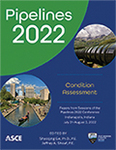Traffic Loading Effects on Rehabilitated Cast Iron Distribution Pipelines
Publication: Pipelines 2022
ABSTRACT
Pipelines buried beneath roadways experience deformation due to traffic loading throughout their service life. For a jointed cast iron pipeline, traffic loading causes displacement and rotation at each joint. When rehabilitating buried cast iron pipes using trenchless technology, the repair is designed to withstand the imposed displacement and rotation. Introducing a circumferential crack to the host pipe represents an extreme scenario for a repair. A finite element model is developed to evaluate cast iron pipeline deformations caused by HS-20 truck loads applied at the ground surface. The loading is applied to the pipe as a distributed load using Boussinesq’s solution for point loads on a semi-infinite elastic half-space. The pipe-soil interaction is modeled as soil springs with linear-elastic behavior. The cast iron joints are modeled with axial, shear, and rotational springs using previously published data based on laboratory testing of field-sampled cast iron joints. The present model is then compared with analytical solutions, past finite element analyses, and past experimental data to verify and validate deformed shape, rotation at the joints and circumferential crack, and relative offset at the circumferential crack. Following validation, properties of a cured-in-place pipe repair are applied to the model and the predicted offsets and rotations tabulated. The results can inform full-scale testing procedures, justifying the experiment geometry, input loads, and corresponding displacements necessary to evaluate the performance of new pipeline repair technologies over a simulated design life.
Get full access to this chapter
View all available purchase options and get full access to this chapter.
REFERENCES
Alzabeebee, S., D. N. Chapman, and A. Faramarzi. 2018. “A comparative study of the response of buried pipes under static and moving loads.” Transp. Geotech. 15, 39–46.
Argyrou, C., T. D. O’Rourke, H. E. Stewart, and B. P. Wham. 2019. “Large-scale fault rupture tests on pipelines reinforced with cured-in-place linings.” J. Geotech. Geoenviron. Eng. 145 (3), 04019004.
AWWA Committee Report. 2019. Structural classifications of pressure pipe linings. Denver, CO: AWWA (American Water Works Association).
García, D. B., and I. D. Moore. 2015. “Performance of deteriorated corrugated steel culverts rehabilitated with sprayed-on cementitious liners subjected to surface loads.” Tunnelling Underground Space Technol. 47, 222–232.
CIPRA (Cast Iron Pipe Research Association). 1927. Handbook of cast iron pipe: for water, gas, steam, air, chemical and abrasives. Chicago, IL.
Ha, S. K., H. K. Lee, and I. S. Kang. 2016. “Structural behavior and performance of water pipes rehabilitated with a fast-setting polyurea-urethane lining.” Tunnelling Underground Space Technol. 52, 192–201.
Harris, C. W., and T. D. O’Rourke. 1983. “Response of Jointed Cast Iron Pipelines to Parallel Trench Construction.”, School of Civil and Environmental Engineering, Cornell Univ., Ithaca, N.Y.
Jeon, S.-S., T. D. O’Rourke, and A. N. Netravali. 2004. “Repetitive loading effects on cast iron pipelines with cast-in-place pipe lining systems.” J. Transp. Eng. 130 (6), 692–705.
Jung, J. K., T. D. O’Rourke, and C. Argyrou. 2016. “Multi-directional force-displacement response of underground pipe.” Can. Geotech. J. 53 (11), 1763–1781.
Kaplan, L. 2020. “AASHTO vehicle live loading.” Structure, 30–33.
McKenna, F. 2011. OpenSees: a framework for earthquake engineering simulation. Comput. Sci. Eng. 13 (4), 58–66.
Netravali, A. N., T. D. O’Rourke, K. I. Gerritsen, Y. P. Singh, S. S. Jeon, and D. Zhao. 2000. “Advanced pipeline support and stabilized backfill for gas mains affected by excavations—Part 2: Cast-in-place pipe lining systems for cast iron and steel gas mains.”, NYGAS, N.Y.
O’Rourke, T. D., A. N. Netravali, S. M. Pendharkar, A. Tonkinson, D. Chaudhuri, and S. Toprak. 1996. “Evaluating service life of anaerobic joint sealing products and techniques.”, Gas Research Institute, Chicago, IL.
O’Rourke, T. D., J. E. Strait, N. Mottl, B. Berger, B. Wham, H. E. Stewart, and D. Price. 2021. Performance evaluation of aqua-pipe under earthquake-induced ground deformation. School of Civil and Environmental Engineering, Cornell Univ., Ithaca, N.Y.
Petersen, D. L., C. R. Nelson, G. Li, T. J. McGrath, and Y. Kitane. 2010. Recommended design specifications for live load distribution to buried structures. Washington, D.C.
Prior, J. C. 1935. Investigation of bell and spigot joints in cast-iron water pipes. Part I: Pullout strength. Part II: Bell strength. Part III: Harness strength. College of Engineering, Ohio State University, Columbus, Ohio.
Rakitin, B., and M. Xu. 2015. “Centrifuge testing to simulate buried reinforced concrete pipe joints subjected to traffic loading.” Can. Geotech. J. 52 (11), 1762–1774.
Sheldon, T., H. Sezen, and I. D. Moore. 2016. “Beam-on-springs modeling of jointed pipe culverts.” J. Perform. Constr. Facil. 30 (2), 04015002.
Shou, K. J., and B. C. Chen. 2018. “Numerical analysis of the mechanical behaviors of pressurized underground pipelines rehabilitated by cured-in-place-pipe method.” Tunnelling Underground Space Technol. 71, 544–554.
Stewart, H. E., T. D. O’Rourke, B. P. Wham, A. N. Netravali, C. Argyrou, X. Zeng, and T. K. Bond. 2015. Technology transfer demonstrations and post-mortem testing of cast iron and steel pipe lined with cured-in-place liners (CIPL). NYSEARCH/Northeast Gas Association, N.Y.
Stewart, H. E., B. J. O’Rourke, T. D. O’Rourke, and B. M. New. 1989. “Evaluation of cast iron pipeline response at excavation crossings.”, School of Civil and Environmental Engineering, Cornell Univ., Ithaca, N.Y.
Terzaghi, K. 1955. “Evaluation of coefficients of subgrade reaction.” Geotechnique, 5 (4), 297–326.
Wham, B. P., C. Argyrou, and T. D. O’Rourke. 2016. “Jointed pipeline response to tunneling-induced ground deformation.” Can. Geotech. J. 53 (11), 1794–1806.
Zhang, F., N. Branam, B. Zand, and M. Van Auker. 2016. “A new approach to determine the stresses in buried pipes under surface loading.” In Proc., 11th Int. Pipeline Conference, New York, NY: American Society of Mechanical Engineers, 1–11.
Information & Authors
Information
Published In
History
Published online: Jul 28, 2022
Authors
Metrics & Citations
Metrics
Citations
Download citation
If you have the appropriate software installed, you can download article citation data to the citation manager of your choice. Simply select your manager software from the list below and click Download.
